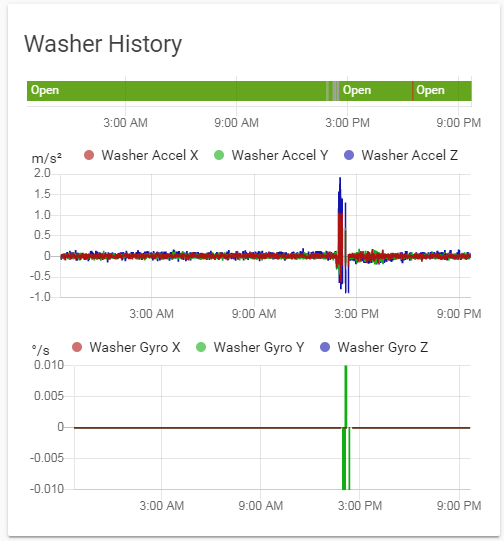This is a guest post by Home Assistant user and contributor Nolan Gilley.
Today I’ll show you how I used Home Assistant, a NodeMCU (ESP8266), and a couple of accelerometers to automate our laundry room. This is a rewrite of an old post where I did the same thing using a Moteino & Raspberry Pi. This version only requires a NodeMCU.
We have an older washer and dryer which doesn’t have any form of notification when cycles complete. Home Assistant was the obvious solution, I just needed to create sensors for the washer and dryer. I tried using sound sensors but found them unreliable. I ended up using an accelerometer attached to the back of each appliance. I also added magnetic reed switches on the doors of the washer and dryer to detect whether they’re open or closed. I connected the accelerometers and reed switches to an NodeMCU which will relay the data to my MQTT broker.
 Block diagram of schematic
After taking some sample data from the accelerometers while each appliance was in operation, I decided to plot the data to help determine the proper thresholds of when the devices were running or off. I had to do this in order to get precise ranges so the dryer sensor wouldn’t get tripped by the washer or vice versa. In the plot below you can see the acceleration in each direction for the accelerometer connected to the dryer. It’s easy to see when the dryer is in operation here. I used the same technique for the washer’s accelerometer.
 Graph showing the accelerometer data
Next it was just a matter of integrating everything with Home Assistant. I was able to use the MQTT component to read the washer and dryer states from the Moteino and display it in Home Assistant.
 Status of the dryer and washer in Home Assistant
Next I wrote scripts that are run whenever the washer or dryer completes a load. This is triggered by the automation component. When the laundry is complete I have the lights in the house turn red and notify me via Join. Once the door is opened and laundry emptied another script runs that sets the lights back to normal. So far it has been very helpful and very reliable.
 NodeMCU connected to MPU-6050 accelerometer.
Materials used:
Sketch for the NodeMCU is available here.
Home Assistant Configuration:
mqtt:
broker: 192.168.1.100
port: 1883
keepalive: 60
qos: 0
sensor:
- platform: mqtt
name: "Dryer Status"
state_topic: "sensor/dryer"
unit_of_measurement: ""
- platform: mqtt
name: "Washer Status"
state_topic: "sensor/washer"
unit_of_measurement: ""
automation:
- alias: Washer complete
trigger:
platform: state
entity_id: sensor.washer_status
from: 'Running'
to: 'Complete'
action:
service: script.turn_on
entity_id: script.washer_complete
- alias: Washer emptied
trigger:
platform: state
entity_id: sensor.washer_status
from: 'Complete'
to: 'Empty'
action:
service: scene.turn_on
entity_id: scene.normal
script:
washer_complete:
alias: Washer Complete
sequence:
- alias: Join Notification
service: notify.join
data:
message: "The washing machine has finished its cycle, please empty it!"
- alias: Living Room Lights Blue
service: scene.turn_on
data:
entity_id: scene.blue
Resources used:
This is a companion discussion topic for the original entry at https://home-assistant.io/blog/2016/08/03/laundry-automation-update/




